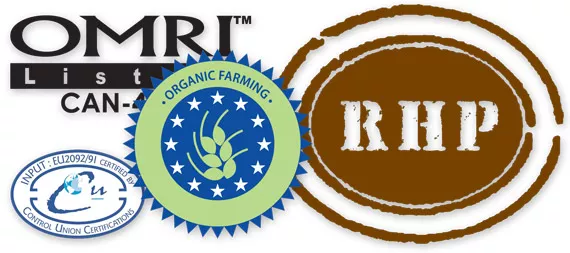Organic, inorganic, mineral, natural, all natural… what do they all mean? How come some of these terms get bantered about so loosely? It’s confusing and made more so by advertising and politics. That aside for now, let's look at the correct meaning of these terms and the implications for the grower when choosing a crop and system.
Let’s start with some basic definitions:
- Mineral
- The inorganic salts, including sodium, potassium, calcium, chloride, phosphate, sulphate. So called because they are (or originally were) obtained by mining. They aren’t necessarily natural.
- Organic
- Chemically, a substance containing carbon in the molecule, with the exception of carbonates and cyanide. Substances of animal and vegetable origin are organic. These organic substances aren’t necessarily natural.
- Inorganic
- Simple enough, not organic. See mineral. Again, these products aren’t necessarily natural.
- Synthetic
- Man-made or, more precisely, not natural: artificial or contrived.
Now that we’ve covered the definitions, let’s look at each one as it relates to selecting parts and components for growing systems.
Plant roots can be selective in terms of the elements they let through the membranes and into the plant itself. It is a system comprised of many components that work by allowing access by diffusion to all elements that are smaller than a particular size. Mineral elements are the ones that will break down and be available faster than anything else.
All elements, including those applied organically, must exist as a single element to cross over into a cell (excluding specialty molecules), and organically applied components are still complex molecules awaiting further breakdown into usable end products. So synthetic inorganic minerals will react quicker with a plant and can be controlled more precisely. They are supplied in many combinations such as ammonium nitrate, calcium nitrate, potassium sulphate, or potassium phosphate, ions that disassociate in solution and the plant can take them up.
Unfortunately, when supplied with undesirable components such as sodium molybdate, or when the ‘mined’ material is not pure, these impurities or undesirable components cause problems. This is especially true where heavy metals are concerned. These undesirable elements can either be deposited into the medium causing salt and other toxicity problems, or they pass into the plant to be deposited into the cell vacuoles where they remain until consumed by the end user or degrade into the soil.
Basic concepts of 'organic'
Organic, as the term is used in the green industry, implies two basic concepts. The first is material that is based on an organic molecule and contains carbon. In this case it is a source of nitrogen and the carbon, as we noted earlier, has to break down to be available. The second concept refers to the end product, plant or fruit that’s harvested or used. Example; if lettuce is organic then everything the crop was given was done with all natural and organic stuff.
Organic components are recognised as either synthetic or natural; they are either man made or not. When the subject is fertiliser, for instance, typically it is the nitrogen that is worked with and everything else is incidental. Natural organic nitrogen is supplied by whole components of once living things from plant or animal components such as manure, leaf mould, or blood meal. These require organisms to finish the breakdown so they, too, must be present and the Nitrogen becomes available slowly.

If the other main components of a fertiliser are needed to make it complete, then it has to be added to the nitrogen mix, or added separately. Using a blend of plant and animal-derived components will get close to all the required elements, but not all. A grower who feeds 100 % organic components will never maximise their crop. Certain components such as calcium are needed in large quantities but are consumed in the degradation process.
Bone meal can be added for the additional phosphorous needed, but this will not be accepted by many organic consumers. Many want no animal by-products to be used either. The next best option is to supplement what is needed and get the ratios correct by using naturally available elements such as calcium carbonate (lime) or rock phosphate.
However, the material can no longer be described as ‘organic’ but is now ‘natural and organic’. As noted earlier, this same description, natural and organic, could apply to a synthetic organic nitrogen and heavy metal contaminated rock phosphate. Confused?
Summary
So, in summary, we see that the term organic means many things and the same thing, so does natural, and yet both can be used at the same time to achieve better results. So what should you do? The grower needs to understand a few important points first:
Certain components exist in almost all natural mineral soils that are suitable to grow in, so why grow in pure organic? Important components such as calcium are supplied in lime, phosphorous exists in all soils too, either as bound or as free while phosphate is the oxidized form and occurs in all mineral soils. Using natural organic components requires the proper root environment containing the microbes necessary to break down the organic components. The physical conditions of temperature, moisture and pH will affect the process and must be taken into account.
A grower that feeds 100 % organic components will never maximize their crop
Growing ‘organic’ requires not just the proper fertiliser. Every component must meet the standards. Growing organically takes time, as the materials used for feed take some time to become broken down enough to supply a plant’s needs. It can be a long process with tens of processes required to take an organic component like a cell wall and turn it into an available single element or specialty molecule like nitrate.
With fertility, natural organic growing requires that a microcosm be established to deal with the organic component needing reduction. You can add all the manure, castings, and blood meal you want to the medium, but without the micro-life, it will just sit there and do nothing. It may break down to a certain degree but will probably not be sufficient to feed a crop. You need organisms that feed on the raw proteins or other components, then another organism to feed on those waste products, and another until the compound is rendered into a plant-usable form. You also need the right balance between these organisms to get the ratio correct in N-P-K values or to supply the trace elements. The correct micro flora have to be present at the right time.
All this has to occur in the root zone in a medium that will support the processes; an organic base with storage sites. So our system is limited to soil or soilless organic based mediums, usually peat, since the values will work with the organics. The best feed to use would be one that is as close to the final stage of breakdown as possible; this takes the variability and guesswork out of it. In a perfect world, giant fermentation tanks would take raw materials and render them into a liquid fertiliser by the careful addition of specific soil-borne microbes that would work on the first step only. Once they had digested everything they could, they would be removed and replaced by the next step’s microbes.

This would be repeated by the same microbes engineered to produce very particular compounds, all the way to the final step, where it would be bottled and sold. Once applied this would be reduced immediately at the root surface to become available, with little delay, to the plant. All the while, the materials and process would be 100% natural and organic and would include nothing added except the microbes (if they are even needed by this step). Wishful thinking? Perhaps, but one that will be feasible with future technologies.
'Organic' organisations
Organisations such as OMRI (the US Organic Materials Review Institute) and the European Control Union look at the materials being labelled organic or organic produced and certify the materials and processes used. Not only do they review the types and origins of materials used, but they also keep an eye on the process from harvest to bottling. They also recognise the inability of pure organics to provide for all the required elements for a plant and allow certain components to be used that are natural and clean.

Some governments regulate the design and content of labels for fertiliser and pesticide labels. Most will not let the word ‘organic’ or ‘natural’ be used on the label unless the product meets certain criteria. Some follow the review institutes’ guidelines, some are much stricter and only allow organic to be used only when the only components of a product are plant-based or animal-based. Registration is designed to protect the purchaser and consumer from cowboy operators selling damaging products with confusing or false claims and statements. The grower has to do the rest of the legwork and decide which route is best for their own growing situation.
When it comes to the consumable products, production is governed pretty well but less so within the hydroponics hobby industry. So, there’s the problem in a nutshell. It is confusing; just remember, do your homework! If you want organic then use OMRI or Control Union listed products: that makes it really easy. Take some advice: keep it simple, understand the way it works, and the limitations it has, but enjoy the benefits of growing ‘organic’. Work within the limits and keep an eye out for that perfect product.

